Eyreville Plantation
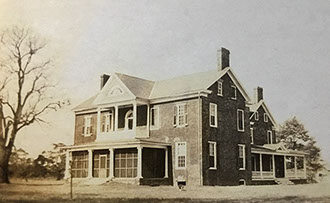
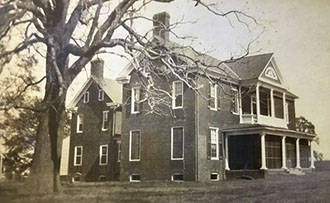
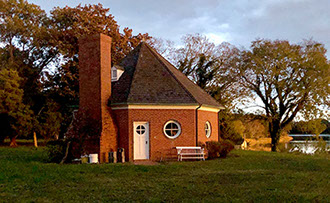
Oyster House
The Virginia Historical Society, Richmond. White Law File, N44 "Eyreville".
Eyreville is a 1,000-acre working grain farm located on Cherrystone Creek, just off the Chesapeake Bay, about 15 miles north of the Chesapeake Bay Bridge-Tunnel.
The Buyrn family moved to Eyreville from Virginia Beach in the early 1980's to avoid urban expansion and continue farming. The grounds have a colorful history, to say the least.
Eyreville is on the rim of a 35 million-year-old meteor impact crater (now filled in) that formed the Chesapeake Bay. Native American artifacts turn up in its fields – some of the richest farmland on the Eastern Shore. And resident ghosts are said to occupy its centuries-old manor house.
No one knows when the first European settler set foot on the property, but according to the Northampton County Courthouse in nearby Eastville, which has the oldest continuous court records in the United States, the place has been legally inhabited since 1637.
Over the years, the farm, once known as Newport Plantation, change hands three times until Colonel William Kendall, speaker of the House of Burgesses in Jamestown, purchased it in 1657 and built various dwellings.
In 1797, Kendall's descendants sold the property to William H. Eyre, and since then it has been known as Eyreville. The brick house that stands there today was built in 1799 and added onto over the years, specifically in 1806 and again in the mid-1940's, then under the ownership of Guy L. Webster.
Fast-forward to 2017, when an accidental discovery was made while a tree stump was being removed from the yard. Always a history lover, Roger Buyrn, along with friend Christopher Derwort, started poking around in the upturned soil. To their astonishment, they were rewarded with multiple colonial-era artifacts: pieces of tobacco pipes, ceramics, yellow bricks, a silver button, a few coins. They connected with state and federal archaeologists, who quickly organized an excavation of the site.
Since then, with the help of many volunteers, archaeologists have unearthed numerous structural features from the 1600s and 1700s – foundations, cellars, hearths. Among the thousands of artifacts: farthings dating to the 1620s and 1630s, jetons (tokens or coin-like discs) from the late 1500s to early 1600s, tobacco pipes from the early 17th century, English and German ceramics. Hundreds of yellow Dutch bricks have surfaced – more than have been found in all of Virginia – leaving archaeologist scratching their heads about exactly who lived at Eyreville and when.
Now, Eyreville is believed to be the oldest colonial site excavated on the Delmarva Peninsula. Archaeologists from the Virginia Department of Historic Resources continue to return, year after year, hoping to one day know the full story of this very special place.
A Tree Fell on the Eastern Shore and Unearthed a Mystery of the Early 1600s
By Joanne Kimberlin - The Virginian-Pilot - Jun 01, 2017
Evidence of a filled cellar or pit related to a post-in-ground structure likely from the early years of occupation.
Several of the Richmond Patent Farthings recovered from the site. These were manufactured between 1625-34
Fragments of a chafing dish from the early decades of the 17th century.
Also recovered, rare artifacts and reviewed documents that indicate trade with Dutch merchants and possibly the occupation of the vicinity by Dutch colonists. We have hundreds of yellow Dutch bricks, manufactured in Gouda and found only on the earliest of colonial sites.
We recovered over 800 locally made tobacco pipes, bowls that were likely manufactured by Native Americans living on the shore and in the Chesapeake region.
This shows what is believed to be one of the houses built by William Kendall in the mid to late 1600s. It measures some 16 feet by 32 feet, has a bulkhead entrance to the cellar in the southwest corner and nicely finished stone-tiled floor in what was likely an “English basement.”
An example of some of the red clay “Chesapeake” pipes made locally and recovered from the site
The bulkhead entrance into the cellar. Note the Dutch brick at the base of the steps. These actually line the base of the entire foundation.
An unusual stone-tiled cellar floor in a house probably built by Kendall.
Artifacts recovered at the site so far complement what we have discovered in the early documents. We have very good evidence of the first years of occupation including a number of Richmond Farthings dating to the 1620s and 1630s, Jetons (tokens or coin-like discs) from the late 1500s to early 1600s, tobacco pipes from the early decades of the 17th century, and a great deal of English and German ceramics from these early years.
An example of some of the imported white ball clay pipes from England and Holland recovered from Eyreville. Note the elaborately decorated Dutch pipe stems.
One of three recovered Hans Krauwinckel II Jetons made in Nuremberg between 1585 and 1635.
A portion of a large dripping pan possibly dating to the 2nd quarter of the 17th century.
Searching for history at Eastern Shore Farm
Rick Hubbard and Mariah Travis sift through the dirt during an archaeological dig taking place at Eyreville, near Eastville Virginia on May 17, 2017. Both Hubbard and Travis are volunteers with an interest in archaeology. (Allison Hess)
It started with an uprooted tree in the yard, which left a big hole, which opened a window into the past. Colonial-era clay pipes and pottery pieces. Hand-forged nails and odd yellow-ish bricks. Tiny coins – one of the oldest types of farthing. And jetons – brass tokens once used for accounting that have rarely been found in this country.
Read the full story here
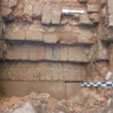
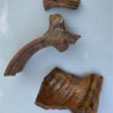
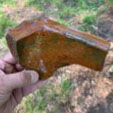
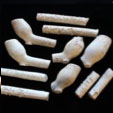
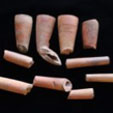
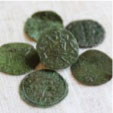
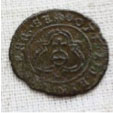
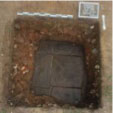
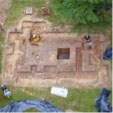
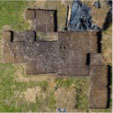
Structures & Artifacts found on Eyreville Plantation
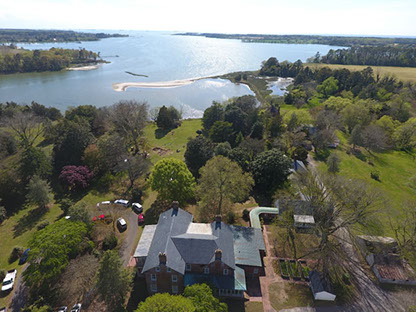
Update on Archaeology at Eyreville, Northampton County
Michael Clem, Archaeologist, Eastern Region Preservation Office - Updated March 5, 2020
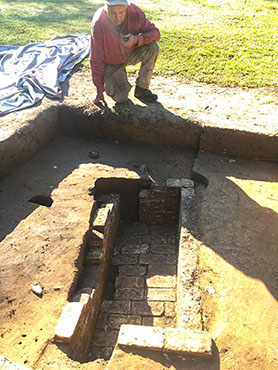
A yellow Dutch brick feature within the site. Its purpose remains a mystery at this point.
The artifacts recovered at the Eyreville site and excavated features, when combined with the documentation, will help us to understand the site as it evolved over time.
DHR staff was first alerted to the possibility of an early colonial site at Eyreville, in Northampton County on Virginia’s Eastern Shore, in the winter of 2017. Since that time DHR has sponsored (in partnership with the Archeological Society of Virginia and the US Forest Service’s Passport In Time program) three field schools and conducted several additional investigations at the site.
What we know about the site from the extensive documents available at the Northampton courthouse archives is that John Howe received a patent for the property in 1637. The documents indicate that Howe already occupied the property at the time. We also know that he was living on the Eastern Shore by 1623 and represented Northampton County in the House of Burgesses at Jamestown. Therefore, it is evident that sometime between 1623 and 1637 he built a house at the site.
Two subsequent owners occupied the property before the end of the 17th century. The third one, Colonel William Kendall, a wealthy trader, served as the Speaker of the House of Burgesses. Documents indicate Kendall built a new house at the site in 1682, just four years before his death. There are also indications that he may have built a house shortly after his purchase of the property in 1657. His descendants held the property until 1799, when it was sold to the Eyre family and a new house was built at that time. The Eyre house still stands on the property. Continuously occupied since Howe first built his house, Eyreville, we believe, is the oldest colonial site to be excavated on the Delmarva Peninsula.
Archaeologically we have discovered remains of one, and possibly two, post-in-ground structures related to the first years of the site. We have also uncovered two larger brick structures that likely represent the houses built by Kendall. This past spring, we also discovered a well with the help of Jamestown Rediscovery’s new ground penetrating radar unit. Subsequent testing was conducted to verify the radar indications and we have determined that it is, indeed, a well. Several other hints at structures and other features have been observed in our excavations, and in the future we hope to be able to better understand the 17th-century landscape at Eyreville.
DHR Virginia News Update on Archaeology at Eyreville Northampton County
Eyreville Plantation


Meet the Horses
Media Features
Reviews
Local Links
Reservations
Eyreville Plantation
Home


